Reported road casualties in Great Britain, final estimates involving illegal alcohol levels: 2019
Published 26 August 2021
About this release
This publication presents final estimates of casualties arising from reported accidents involving at least one motor vehicle driver or rider over the legal alcohol limit for driving, in Great Britain in 2019. Figures are derived from the STATS19 forms completed by the police plus toxicology data for road fatalities from coroners and procurators fiscal. This is an update, based on more complete data, of the provisional 2019 estimates which were published in February 2021.
Main points
Final estimates for 2019 show that between 210 and 250 people were killed in accidents in Great Britain where at least one driver was over the drink-drive limit, with a central estimate of 230 deaths.
The final estimate of fatalities for 2019 is broadly in line with the last few years, and is not statistically significantly different from 2018 at the 95% confidence level.
Chart 1: Fatalities in reported drink-drive accidents: GB, 2009 to 2019; error bars show 95% confidence intervals
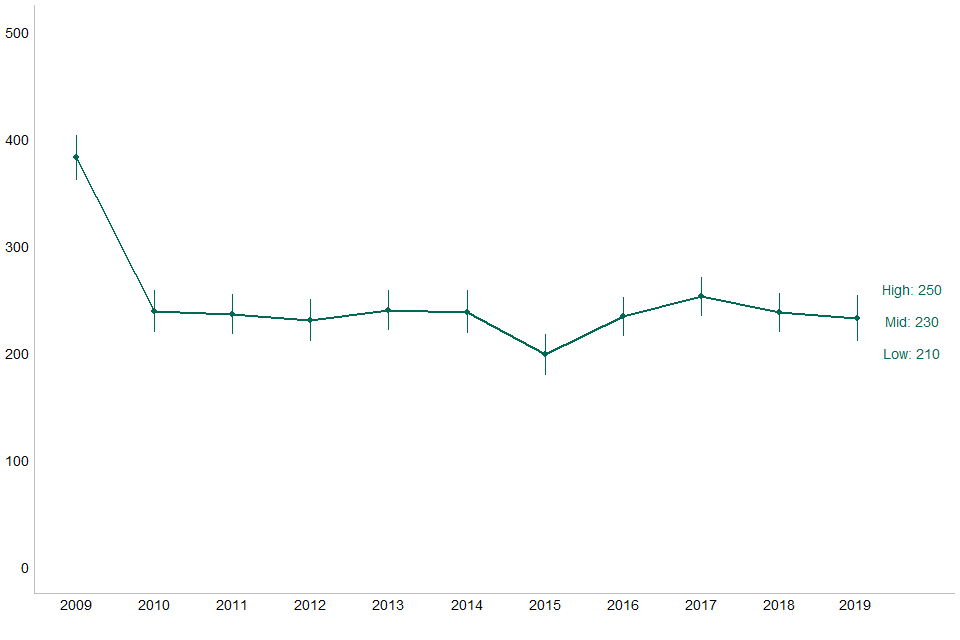
An estimated 7,800 people were killed or injured when at least one driver was over the drink-drive limit. This represents a fall of 10% from 8,680 in 2018 and is the lowest figure recorded.
The total number of accidents where at least one driver was over the alcohol limit decreased by 9% to 5,350 in 2019, the lowest number of drink-drive accidents recorded.
In 2019, the number of killed or seriously injured (KSI) casulties in drink-drive accidents rose while all casualties fell. This was because the number of seriously injured casualties in accidents in which at least one driver or rider failed a breath test rose, while the number of slightly injured in these accidents fell compared to 2018.
Chart 2: Drink-drive fatalities, Killed or Seriously Injured (KSI) casualties and total casualties: GB, 2019

Casualties in drink-drive accidents in 2019
Drink-drive fatalities
These statistics, especially the number of fatalities, are subject to considerable uncertainty (see sampling uncertainty below). This means that it is impossible to be sure of the precise number of fatalities, so ranges and confidence intervals are used for fatalities throughout the publication.
The 95% confidence level is the standard against which statistics are typically tested. The bars on chart 1 are ranges of values for an estimate which we are 95% confident that the ‘true’ value falls in. Technically, it indicates that in 100 years with the same risk of fatalities (or injury), 95 of those years will result in a number of fatalities (or injuries) between a given range.
When we compare figures for the latest year with the previous year, we say that a change is ‘statistically significant’ if we are sufficiently confident (at the chosen level – here, 95%), based on the data available, that the difference between the 2 figures is the result of a genuine change, rather than being a product of chance - broadly, this is when the 2 sets of bars on chart 1 don’t overlap. Otherwise, we say the change is ‘not statistically significant’ – this does not necessarily mean that there is not a genuine change, but that we are not able to determine one exists from the data available, at the chosen level of confidence.
The final central estimate of the number of deaths in accidents with at least 1 driver over the alcohol limit for 2019 is 230. This represents about 13% of all deaths in reported road accidents in 2019. The central estimate for 2019 is lower than the final figure for 2018, but the decrease is not statistically significant. The 95% confidence range indicates that we can be 95% confident that the true figure, is between 210 and 250 fatalities.
The final estimate for 2019 is based on coroners’ and procurators’ fiscal reports for 80% of the drivers or riders who were killed in road traffic accidents in that year in addition to breath tests taken at the scene where the driver was not killed (see definitions below).
The prevalence of drink-driving in road deaths has fallen over time. In 1979, 26% of road deaths occurred in accidents where at least one driver or rider was over the drink-drive limit. This had fallen to 15% by 1989. Since then the percentage of road deaths that are drink-drive related has varied between 12% and 18%. In 2019, the rate was 13%.
Chart 3: Fatalities in reported drink-drive accidents, as a percentage of all fatalities: GB, 1979 to 2019
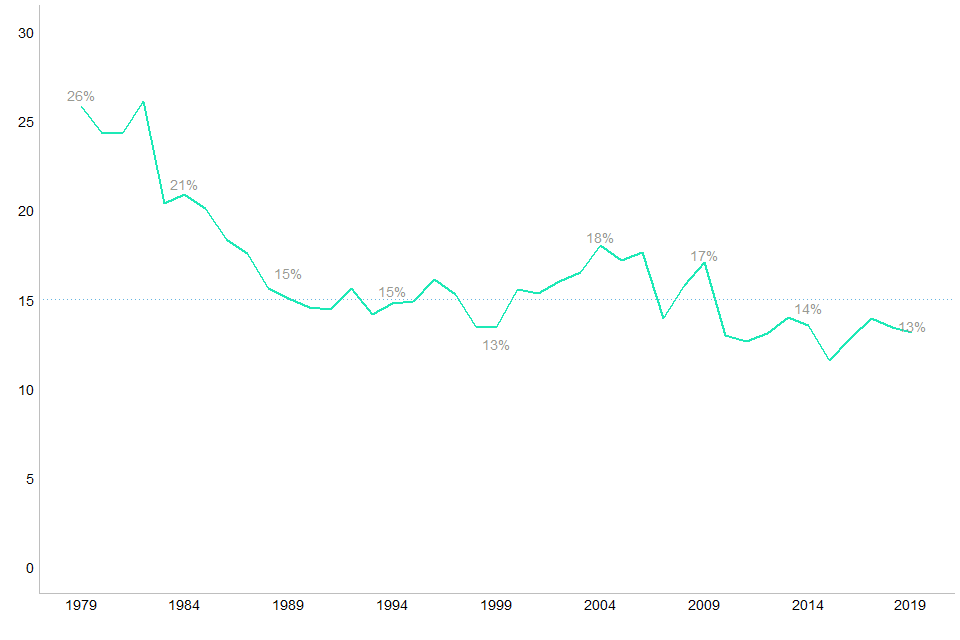
Drink-drive killed or seriously injured (KSI) casualties
We are publishing KSI drink-drive casualties as part of these statistics for the first time this year. This is possible due to the availability of severity adjustments for non-fatal injuries to take account of changes in accident reported systems. For information on the adjustments see ‘changes in systems for severity reporting’ below.
The central estimate of the number of killed or seriously injured (KSI adjusted) drink-drive casualties in 2019 is 2,050, an increase of 8% on 2018. This is the highest level since 2011.
Chart 4: Killed or seriously injured (KSI adjusted) casualties in reported drink-drive accidents: GB, 2009 to 2019

The proportion of killed or seriously injured (KSI adjusted) casualties in drink-drive accidents has varied between 5% and 7% since 2005. In 2019, the rate was 6%.
Chart 5: Killed or seriously injured (adjusted) casualties (KSI) in reported drink-drive accidents, as a percentage of KSI casualties: GB, 2005 to 2019
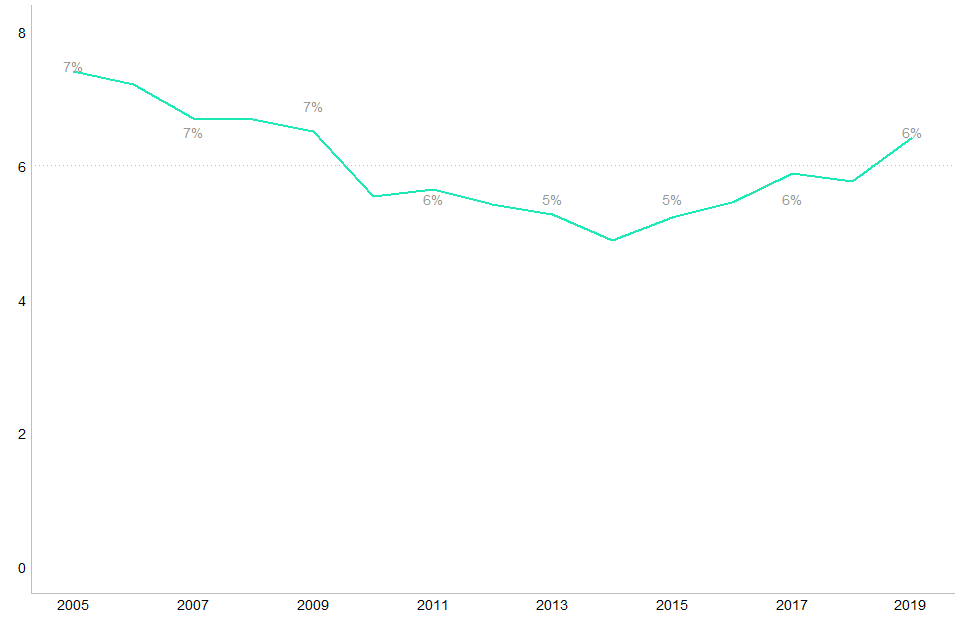
All drink-drive casualties
The central estimate of the number of drink-drive casualties of all severities in 2019 is 7,800, a fall of 10% from 8,680 compared to 2018. This is the lowest level recorded.
Chart 6: Total casualties in reported drink-drive accidents: GB, 2009 to 2019
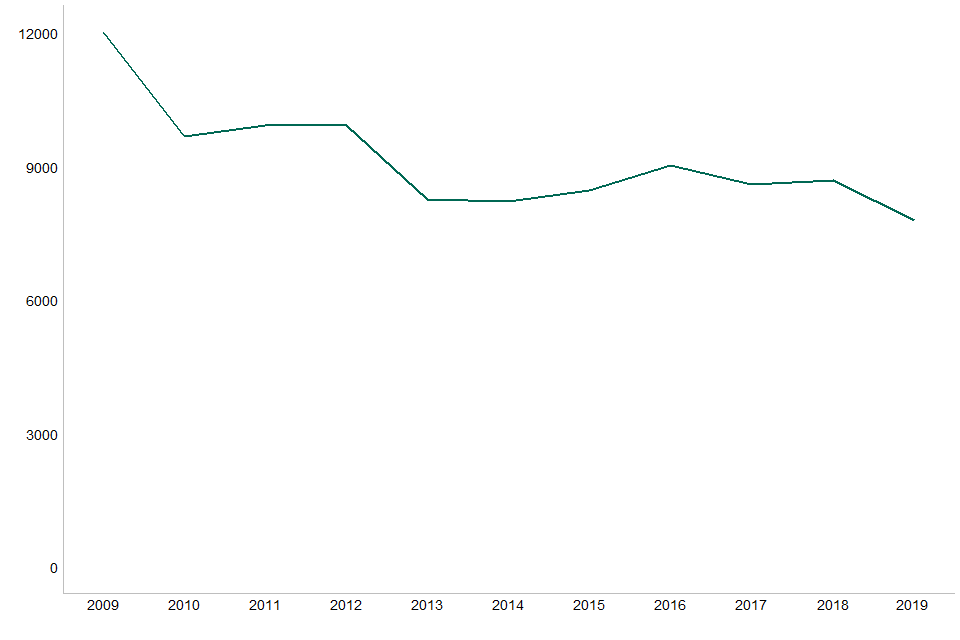
It is estimated that around 5% of all casualties in reported road accidents in 2019 were involved in accidents in which at least one driver or rider was over the drink-drive limit.
In 1979, 9% of road casualties occurred in accidents in which at least one driver or rider was over the drink-drive limit. This has fallen to 5% by 1992 and has mainly varied around 5% since then.
Chart 7: Casualties in reported drink-drive accidents, as a percentage of all casualties: GB, 1979 to 2019
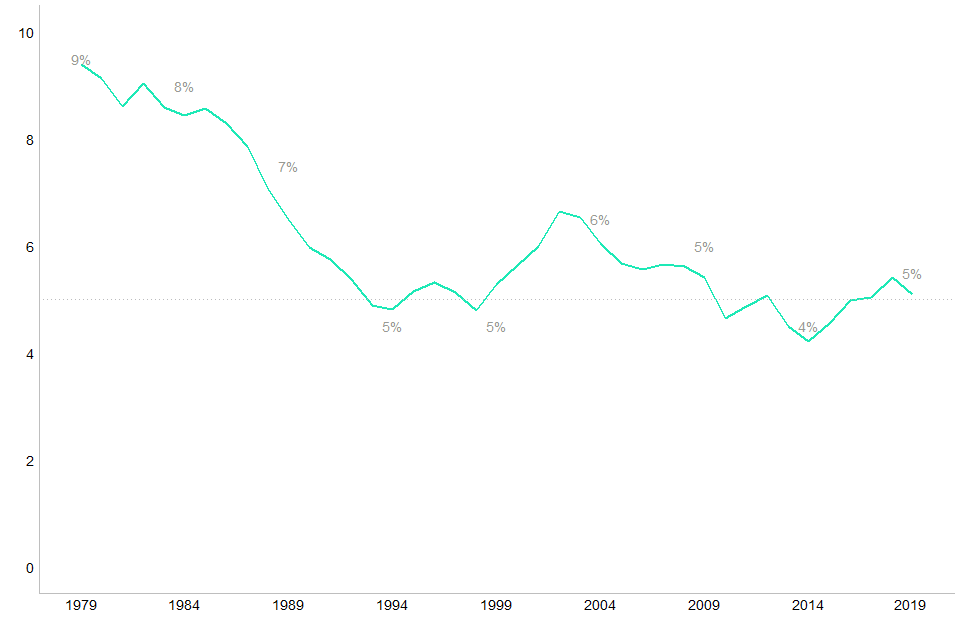
Number of drink-drive accidents in 2019
Trends in drink-drive accidents are similar to those for casualties.
There were an estimated 210 fatal drink-drive accidents in 2019 unchanged from 2018.
The total number of drink-drive accidents of all severities fell by 9% from 2018 to 2019 to 5,350, to the lowest number recorded. This means that around 5% of all reported road traffic accidents in 2019 involved at least 1 driver or rider over the legal alcohol limit.
In 1979, 8% of reported road accidents were drink-drive related. This fell to 5% by 1990 and has generally been around 5% since then.
It is important to note that the number of overall road traffic accidents has fallen, from 254,967 in 1979 to 117,536 in 2019, a 54% reduction. However, drink-drive accidents have fallen further; down 73% since 1979. It is therefore likely that some drink-drive initiatives have been effective in reducing the number of drink-drive accidents.
Chart 8: Reported accidents and drink-drive accidents: GB 1979 to 2019 (index 1979 = 100)
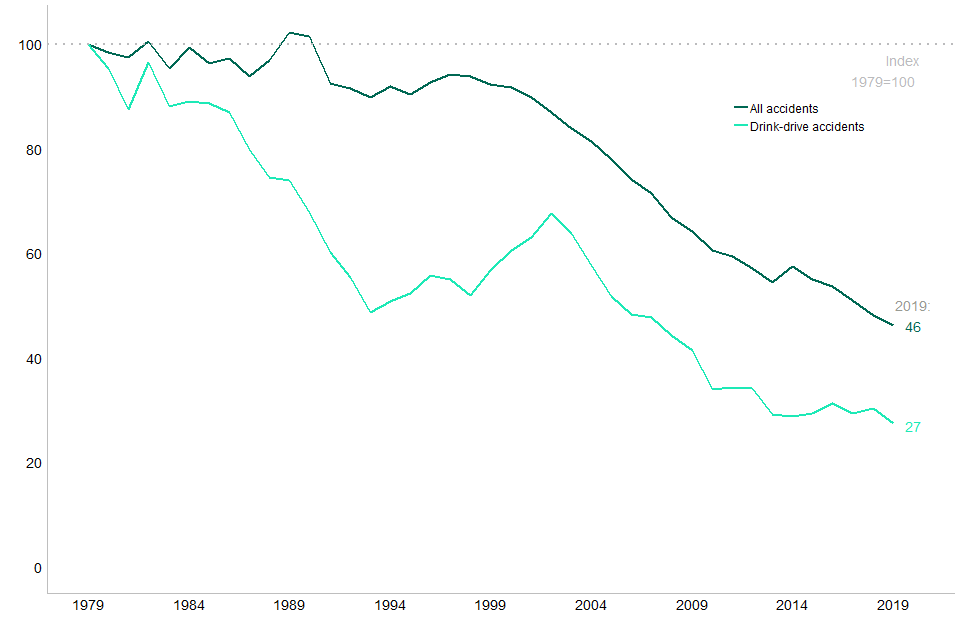
Drink-drive casualties by country and English region
Overall, 5% of casualties in reported road accidents in 2019 occurred in accidents in which at least one driver or rider was over the drink-drive limit. This varied across the countries of Great Britain.
The percentage of all casualties which occurred in drink-drive accidents was the highest in Wales at 6.9% followed by England at 5.1% and Scotland at 4.6%.
Within the English regions, the casualty rates varied from 7.0% in the East Midlands to Greater London at 2.9%.
Chart 9: Percentage of casualties occurring in drink-drive accidents by country and English region, 2019
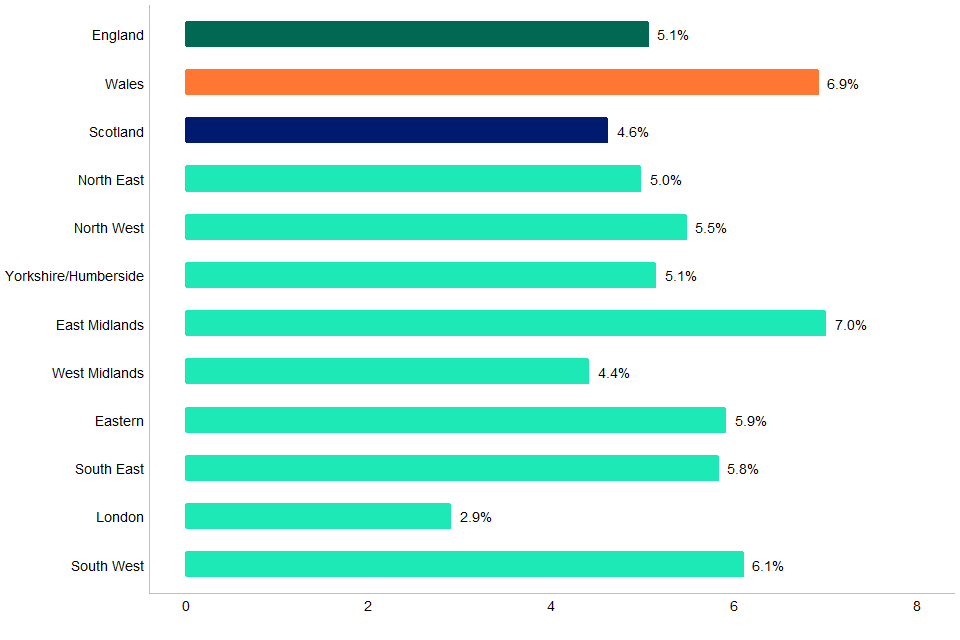
Since 2010, the proportion of casualties that occur in drink-drive accidents has been higher in Wales than in England or Scotland. Please note that the variability in figures for Scotland might be due to low underlying numbers in the estimation.
Chart 10: Percentage of casualties occurring in drink-drive accidents by country, 2010 to 2019
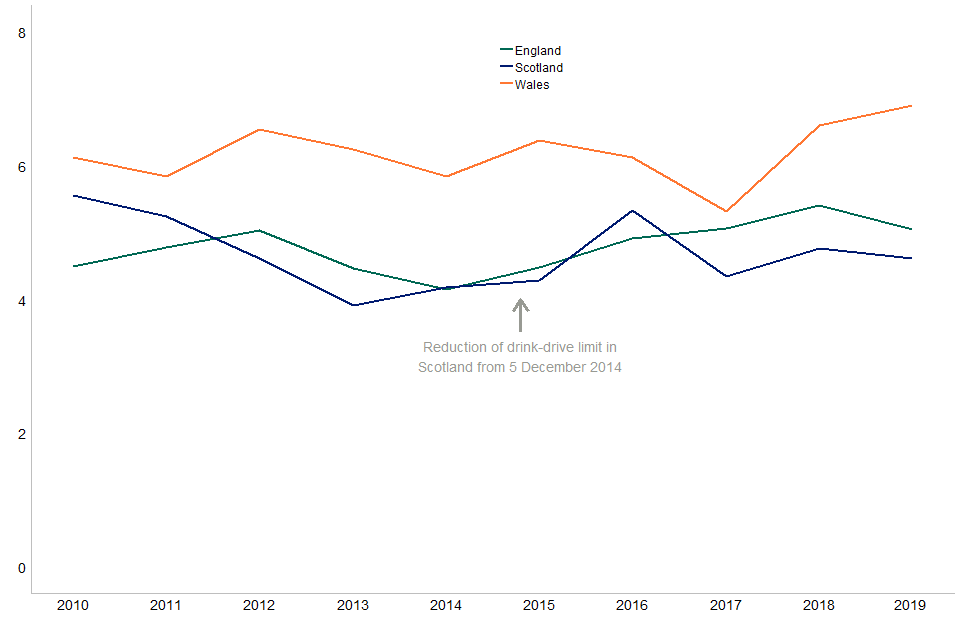
Casualties in drink-drive accidents by sex
In 2019, 78% of drink-drive accidents involved male drivers or riders over the legal alcohol limit. Some accidents will involve both male and female drivers over the limit, and sex is unknown for some drivers. However, males make up 69% of drivers (excluding pedal cyclists and horse riders) involved in all accidents where the sex of the driver is known.
In 2019, 67% of casualties in drink-drive accidents were male compared to 60% in all reported road accidents.
Chart 11: Drivers involved in drink-drive accidents and all reported accidents, by sex, GB: 2019

Casualties in drink-drive accidents by age
A higher proportion of casualties in drink-drive accidents were aged between 25 and 59 than in all reported accidents in 2019 (63% in drink-drive accidents compared to 56% in all accidents). The same was true for people aged 16 to 24 (23% in drink-drive accidents compared to 19% in all accidents).
Older people (aged 60+) represented a lower proportion in drink-accidents than accidents overall (8% in drink-drive accidents compared to 14% in all accidents). Children (under 16) also were less likely to be casualties in drink-drive accidents (5% compared to 9% in all accidents).
The percentages in the charts below do not add up to 100 as the percentages where the age of the casualty is unknown is not shown.
Chart 12: All casualties in drink-drive accidents and all reported accidents, by age group, GB: 2019
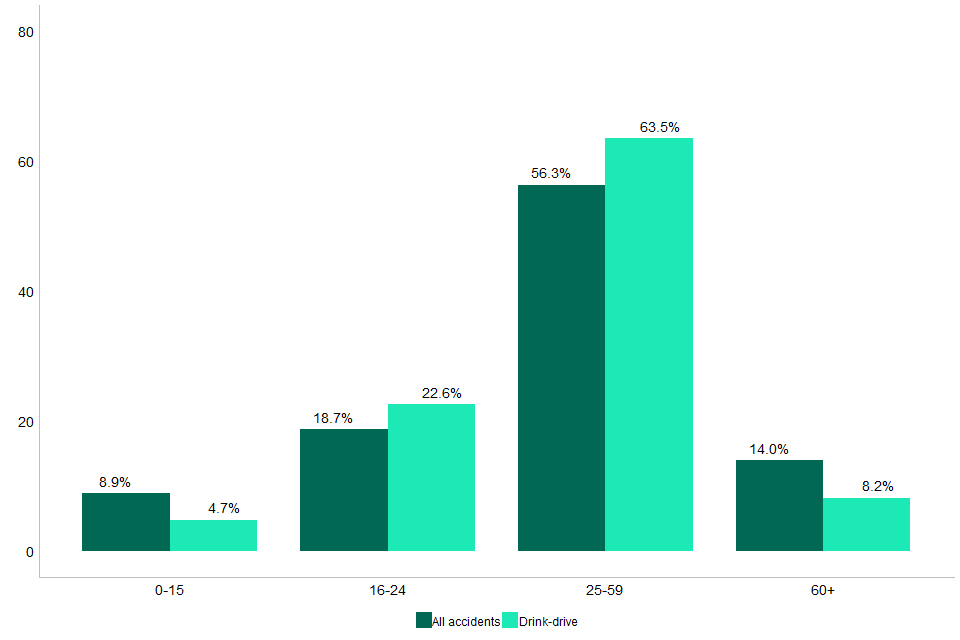
Compared to all road accidents, a lower proportion of pedestrian casualties in drink-drive accidents in 2019 were children under 16 (12% compared to 24% in all accidents). The same is true of car occupant casualties (4% of car occupant casualties were children in drink-drive accidents compared to 6%in all accidents).
Conversely, a higher proportion of pedestrian casualties in drink-drive accidents in 2019 were aged 16 to 24 (18% in drink-drive accidents compared to 15% in all accidents). The same was true for car occupants of this age group (24% in drink-drive accidents compared to 20% in all accidents).
For 25 to 59 year olds a higher proportion of pedestrian casualties occurred in drink-drive accidents than in all reported accidents in 2019 (52% in drink-drive accidents compared to 41% in all accidents). Similarly, a higher proportion of motorcycle casualties aged between 25 and 59 occurred in drink-drive accidents than in all reported accidents in 2019 (66% in drink-drive accidents compared to 62% in all accidents). The same is the case among car occupants of this age cohort (63% in drink-drive accidents compared to 57% in all accidents).
Older people (aged 60+) represented a lower proportion of pedestrian casualties in drink-drive accidents than accidents overall (15% in drink-drive accidents compared to 18% in all accidents). They also represented a lower proportion of motorcycle casualties in drink-accidents than accidents overall (2% in drink-drive accidents compared to 7% in all accidents). The same in the case among car occupants of this age group (8% in drink-drive accidents compared to 15% in all accidents). Conversely, older people represented a higher proportion of pedal cyclist casualties in drink-accidents than accidents overall (13% in drink-drive accidents compared to 8% in all accidents).
Chart 13: Casualties in drink-drive accidents and all reported accidents, by road user type and age group, GB: 2019

Background information
Tables published with this release
With this release, the headline table on drink-driving, RAS51001, has been updated with final 2019 figures. It shows accidents and casualties by severity since 1979. The provisional update for 2020 will be published in February 2022.
The tables on drink-driving are organised by topic:
- Drink-drive accidents and casualties by severity overview, disaggregated by sex, country and English region and month of accident
- Drink-drive accidents by time of day, by pedestrian and vehicle involvement. Estimated number of reported accidents involving a car drink-driver by age
- Drink-drive casualties by casualty type, sex and age and those involving a young driver over the limit
- Drink-drive fatalities by drivers and riders killed over the drink-drive limit, by blood alcohol category and age, blood alcohol levels of all fatalities
Other related data sources
Breath test data for 2020 will be published in September 2021 alongside the Reported Road Casualties Great Britain: 2020 Annual Report. Breath test data for 2019 is available.
Statistics on the results of roadside breath alcohol screening tests, administered by police forces in England and Wales in 2019, using digital breath testing devices is available.
The devices are able to record exact breath alcohol readings and the result of individual tests, as well as reason for test, and age and sex profiles of those tested. The results are downloaded to data systems on a monthly basis and provided to the Department for Transport. These data are not provided by all police forces so are incomplete and therefore do not cover England and Wales as a whole.
The Crime Survey for England and Wales can be used to look at trends in self-reported drink driving by age, sex and frequency of alcohol consumption is available. Within the survey a driver is considered to be anyone who stated they had driven at least once in the past 12 months. These will not be updated this year as the survey has not taken place as a result of the COVID-19 pandemic.
Data is also provided for self-reporting of the following:
- driving after taking medication with advice not to drive
- driving under or over the drink-drive limit
- drug driving
- diving after taking legal highs
- mobile phone use when driving
Analysis on the number of roadside tests carried out by police in England and Wales is produced by the Home Office. The figures show geographic patterns and seasonal variation. Commentary is also provided to aid the interpretation of the trends.
The motoring tool produced by the Ministry of Justice can be used to explore trends in driving convictions. The tool presents information about activity within the criminal justice system, relating to specific motoring offences. Information is provided by age, sex, court type and area, with details about the outcome of court proceedings including the fine amount and sentence length. Data on driving convictions is available.
Definitions used throughout this publication
Drink-drive accident:
A reported incident on a public road in which someone is killed or injured, where at least one of the motor vehicle drivers or riders involved met one of these criteria:
- failed a roadside breath test by registering above 35 micrograms of alcohol per 100ml of breath (in England and Wales) or 22 micrograms (in Scotland)
- refused to give a breath test specimen when requested by the police (other than when incapable of doing so for medical reasons)
- died, within 12 hours of the accident, and was subsequently found to have more than 80 milligrams of alcohol per 100ml of blood (in England and Wales) or 50 milligrams (in Scotland)
Drink-drive casualties: All road users killed or injured in drink-drive accidents.
A full list of the casualty definitions used in this release is available.
Developing drink and drug driving statistics
Reviewing the frequency and improving the timeliness of drink-drive estimates
We want to further improve the quality and timeliness of road safety data. Currently, provisional drink-drive estimates are released 14 months after the end of the year reported on (with a return rate around 30% from coroners), and final estimates are released 20 months after the end of the year (with a return rate around 60% from coroners).
The range of uncertainty associated with the lower return rate at the provisional stage means that it is very unlikely the provisional publication can detect significant changes in the underlying trends. Therefore, the road safety team in the longer term aims to reduce the delay from the end of the year to the date of publication making the releases more timely.
The road safety team is working to allow the data collection from coroners to start earlier and more regularly based on STATS19 data. The aim is to improve the overall response rate and allow the publication of final drink-drive estimates to be released in less than 20 months after the end of the year. This approach is currently being tested; though initial findings were encouraging the COVID-19 pandemic has impacted on data supply timescales over the past year.
The return rates at the final stage for the last 4 years are as follows:
- 2016: 83%
- 2017: 86%
- 2018: 87%
- 2019: 80%
The figure for the latest year 2019 is lower than previous years due to the COVID-19 pandemic. We aim to increase the return rate post-pandemic.
We welcome your feedback on this approach, specifically how you are using these statistics and whether this meets your needs (see contact details).
Drug-driving statistics
The road safety team is currently exploring the feasibility of producing initial statistics on drug-driving from the same coroners data which forms part of these drink-drive statistics. We aim to publish results of exploratory work focussing on drugs detected in deceased drivers as part of the annual reported road casualty statistics in September.
National Statistics
National Statistics are produced to high professional standards as set out in the Code of Practice for Statistics. They undergo quality assurance reviews to ensure that they meet customer needs. The statistics were last assessed during 2013 and the report number 258 is available.
Details of ministers and officials who receive pre-release access to these statistics up to 24 hours before release are available.
Background on legislation
The Road Safety Act 1967 introduced the first drink-driving limit in the UK, set at a maximum blood alcohol concentration of 80mg of alcohol per 100ml of blood (or the equivalent 107mg of alcohol per 100ml of urine). It became an offence to drive, attempt to drive or be in charge of a motor vehicle on a road or other public place with a BAC that exceeded the maximum prescribed legal limit. The 1967 Act also made it an offence to fail to provide a specimen for a laboratory test without reasonable excuse.
The Transport Act 1981 introduced evidential breath testing and established a maximum breath alcohol concentration of 35 micrograms of alcohol in 100ml of breath. This was implemented in 1983. Today, people are given a preliminary breath test at the roadside and then taken back to the police station for an evidential breath test.
Drink-driving legislation has been strengthened over the years, including tougher penalties for offenders which can include potentially unlimited fines, disqualification from driving, or facing imprisonment for the most serious offences.
On 5 December 2014, Scotland reduced the legal BAC limit for all drivers from 80mg/100ml of blood to 50mg/100ml. The drink drive limit introduced by the 1967 Act remains in place for England and Wales today.
Evaluation of changes to the drink-drive limit
An independent evaluation of the impact of the limit reduction in Scotland led by the University of Glasgow was published in the Lancet on 12 December 2018. This evaluation took advantage of the natural experiment created by the lowering of the legal blood alcohol limit in Scotland only and compared data on weekly road traffic accident rates and alcohol consumption (off and on sales data) between Scotland (the intervention group) and England and Wales (the control group).
The study found that lowering the drink-drive limit was not associated with any reduction in total accident rates or serious and fatal accident rates, but that the change was associated with a small reduction in per-capita alcohol consumption from on trade alcohol sales.
Quality and methodology
How do final estimates differ from the provisional estimates?
The final estimates have a narrower range than the provisional estimates. This is because the final estimates are based on more toxicology reports from coroners and procurators fiscal.
The main changes between the provisional and final estimates are for fatalities. This is because the data for fatal drink-driver accidents comes predominately from the toxicology reports while non-fatal drink-drive accidents data is derived mainly from breath test data. Breath test data is complete when the provisional estimates are published
The provisional estimate of the number of fatalities in drink-drive accidents has usually been higher than the final estimate in recent years, as the table below shows.
Table: Estimated number of drink-drive fatalities at provisional and final stage, GB: 2015 to 2019
| Year | Final estimate | Provisional estimate |
|---|---|---|
| 2019 | 230 | 280 |
| 2018 | 240 | 240 |
| 2017 | 250 | 290 |
| 2016 | 230 | 240 |
| 2015 | 200 | 220 |
Sampling uncertainty
Toxicology data are not available for all killed drivers and riders recorded in STATS19 and are typically available for around 60% to 70% of relevant cases for final estimates. Provisional estimates for 2019 are based on around 30% of relevant cases.
To account for the killed drivers without a known Blood Alcohol Content (BAC), the casualties from the known cases are scaled up. The estimates are therefore based on a sample, rather than a complete count, which introduces an element of uncertainty.
Due to the nature of the data used to create these estimates, there is considerably more uncertainty in the number of fatalities and fatal accidents than any other severity level. The reason for this is that 51% of fatalities in 2019 were motor vehicle drivers themselves.
Under-reporting of road casualties
The estimates in this release are based only on those road accidents which are reported to the police. Comparisons of road accident reports with death registrations show that very few, if any, road accident fatalities are not reported to the police. However, it has long been known that a considerable proportion of non-fatal casualties are not known to the police. The data used as the basis for these statistics are therefore not a complete record of all personal injury road accidents, and this should be borne in mind when using and analysing the figures.
Changes in systems for severity reporting
Non-fatal casualties since 2016 have been affected by a large number of police forces changing their reporting systems which has had a large impact on the classification of injuries recorded. Further details are in the 2019 annual report.
Methodology details
A methodology note is available describing how the estimates are compiled from the sources.
Instructions for printing and saving
Depending on which browser you use and the type of device you use (such as a mobile or laptop) these instructions may vary.
You will find your print and save options in your browser’s menu. You may also have other options available on your device. Tablets and mobile device instructions will be specific to the make and model of the device.
How to search
Select Ctrl and F on a Windows laptop or Command and F on a Mac
This will open a search box in the top right-hand corner of the page. Type the word you are looking for in the search bar and press enter.
Your browser will highlight the word, usually in yellow, wherever it appears on the page. Press enter to move to the next place it appears.
Contact details
Road safety statistics
Email roadacc.stats@dft.gov.uk
